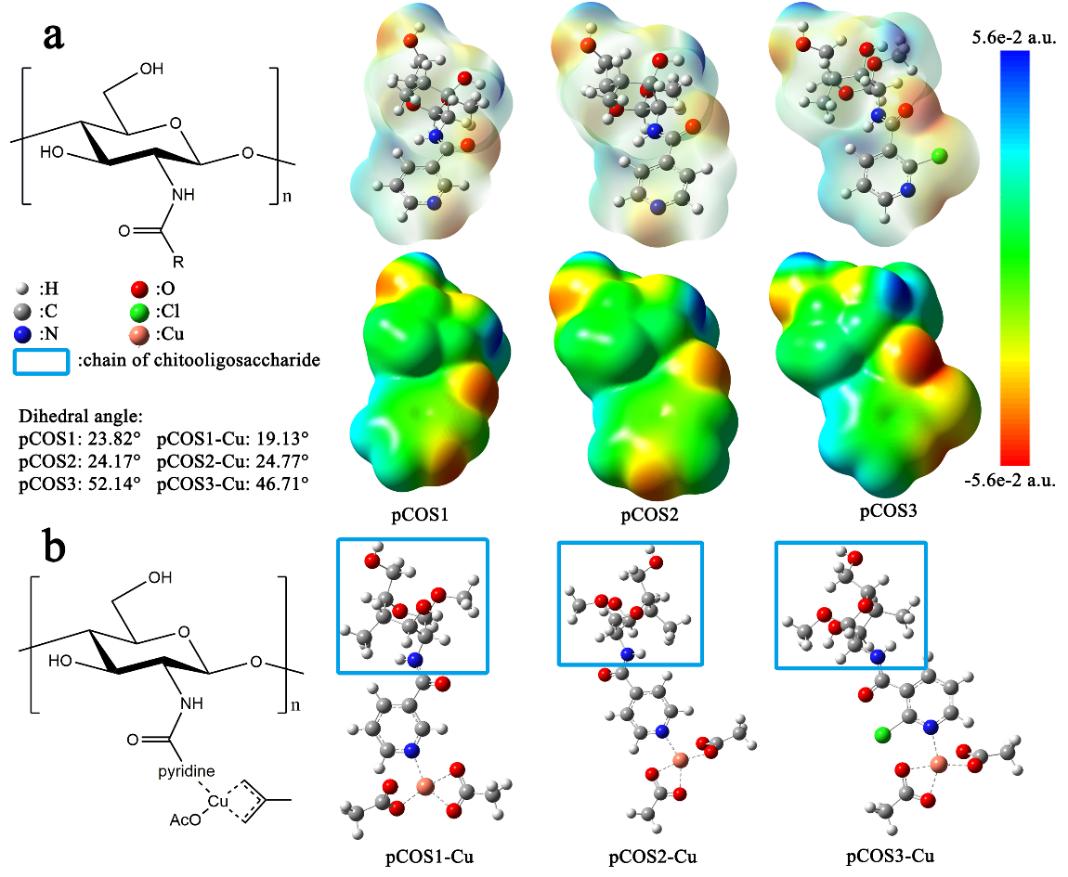Copper fungicides have been widely used for more than 150 years, which have the advantages of a wide sterilization spectrum, low cost and low drug resistance, but what cannot be ignored are their toxicity to plant growth and damage to the environment. Therefore, the application of novel, low toxicity biogenic copper fungicide has strong industrial prospects.
Recently, Dr. LIU Weixiang of Prof. LI Pengcheng's team from the Institute of Oceanology of the Chinese Academy of Sciences (IOCAS) provided new insight into the design and synthesis of slow-release organic copper fungicides based on chitooligosaccharide (COS).
The study was published in Carbohydrate Polymers on May 26.
Researchers presented that the construction of conjugated system is a feasible method for the design and synthesis of slow-release COS copper complexes. Based on this, they synthesized pyridinylcarbonyl chitooligosaccharide ligands (pCOSx) and their copper complexes (pCOSx-Cu). Results showed that a slowly dissociated coordination bond was formed between the nitrogen atom of pyridyl and Cu2+ in pCOSx-Cu because of the formulation of a p-π-π conjugated system in pCOSx.
The cumulative release rate of Cu2+ is positively correlated with the electron donating ability of pyridyl. From the perspective of Phytophthora capsici Leonian control, pCOS2-Cu synthesized by isonicotinoyl chloride has the best antifungal activity and root protection effect. When the concentration was 0.8 mg/mL, pCOS2-Cu completely inhibited the growth of mycelium in vitro. Researchers found pCOSx-Cu has better antifungal activity, lower toxicity and lower metal content than commercially available copper fungicides. In addition, due to the introduction of COS, the root activity of seedlings increased with higher pCOSx-Cu concentration.
Chitooligosaccharide metal complexes have different physicochemical properties and biological activities because of their structural diversity, yet the relationship between their slow-release performances and molecular structures has not been elucidated.
"With this regard, pyridinylcarbonyl chitooligosaccharide copper complexes with different conjugated systems were constructed in this study, and their slow-release performances and biological activities were further explored, which will help to understand the structure-activity relationship of chitooligosaccharide copper complexes," said Dr. LIU, first author of the study.
"The pyridinylcarbonyl chitooligosaccharide copper complexes possess good biological activity and environmental sustainability; it offers the possibility for use in the comprehensive management of crop fungal diseases. This discovery lays a foundation for the in-depth study of green copper fungicides based on marine biomacromolecules," said Prof. LI.
The research was supported by the National Key R&D Program of China, National Natural Science Foundation of China and Shandong Provincial Natural Science Foundation.

Fig. 1 (a) Electrostatic potential surfaces of the pCOSx unit; (b) Molecular unit configuration of pCOSx-Cu.

Fig. 2 (a) Slow-release performances of pCOSx-Cu; (b) Antifungal activity of COS, pCOSx and pCOSx-Cu against P. capsica; (c) Protective and curative activity of pCOSx-Cu against P. capsica; (d) Root activity of pepper seedlings treated with pCOSx-Cu.
Liu W., Qin Y., Liu S., Xing R., Li P.* (2022). Synthesis and antifungal activity of slow-release pyridinylcarbonyl chitooligosaccharide copper complexes. Carbohydrate Polymers.
LIU Weixiang
Institute of Oceanology
E-mail: liuweixiang@qdio.ac.cn
(Editor: ZHANG Yiyi)
|
|

Address: 7 Nanhai Road, Qingdao, Shandong 266071, China
Tel: 86-532-82898902 Fax: 86-532-82898612 E-mail: iocas@qdio.ac.cn


